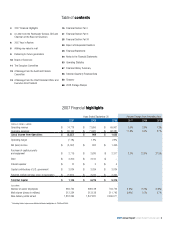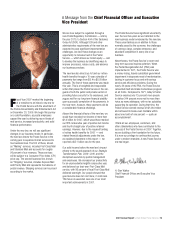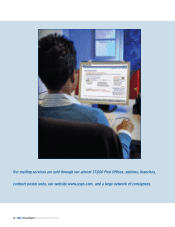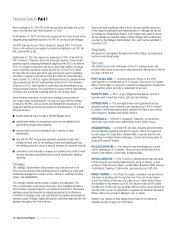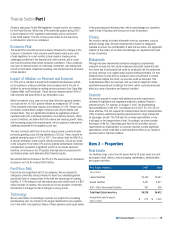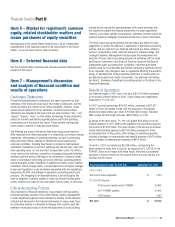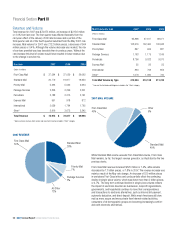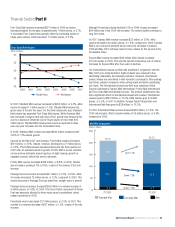US Postal Service 2007 Annual Report Download - page 13
Download and view the complete annual report
Please find page 13 of the 2007 US Postal Service annual report below. You can navigate through the pages in the report by either clicking on the pages listed below, or by using the keyword search tool below to find specific information within the annual report.
2007 Annual Report United States Postal Service | 13
Fiscal Year 2007 marked the beginning
of a transition to an historic new era for
the Postal Service with the enactment of
the Postal Accountability and Enhancement Act
on December 20, 2006. We begin this journey
on a solid foundation, as postal employees
capped the year by delivering record levels of
mail service, increased productivity, and solid
financial performance.
Under the new law, we will see significant
changes in our business model. In particular,
the new law directs the Postal Service in the
coming year to separate its mail services into
two business lines. The first of these, known
as “Mailing” services, includes First-Class Mail
and Standard Mail and accounts for roughly
90 percent of our revenues. These services
will be subject to a Consumer Price Index (CPI)
price cap. The second business line, known
as “Shipping” services, includes Express Mail
and Priority Mail and represents the balance of
postal revenue. Shipping services can be priced
according to the market.
We are now subject to regulation through a
new Postal Regulatory Commission — and by
the year 2010, to Section 404 of the Sarbanes
Oxley Act (SOX). Although SOX and other
administrative requirements of the new law are
expected to pose significant implementation
challenges, we view these changes as an
opportunity to increase trust in the Postal
Service — which drives our brand equity — and
to develop the business by identifying ways to
improve processes, reduce costs, and advance
our business practices.
The new law also directs us to fund our retiree
health benefits through a 10-year schedule of
payments that range from $5.4 to $5.8 billion
annually. The first of these payments was made
this year. This is a farsighted and responsible
action that places the Postal Service in the van-
guard of both the public and private sectors in
providing future security for its employees, and
augurs well for our long-term financial stability
upon successful completion of the payments. In
the near term, however, these payments will be
a considerable financial challenge.
Absent the financial effects of the new law, we
would have recorded net income of more than
$1.6 billion for 2007, which would have marked
our fifth consecutive year of positive net income
and fourth straight year of positive retained
earnings. However, due to the required funding
of retiree health benefits for 2007 — and
related financial adjustments under the law,
as explained elsewhere in this report — we
reported a $5.1 billion loss for the year.
Our solid income before the new law’s impact
attests to the sound approach of our Strategic
Transformation Plan, 2006–2010, and the
disciplined execution by postal management
and employees. We increased our productivity
for an unprecedented eighth consecutive year,
and delivered our best-ever First-Class Mail
service, with 96 percent of local First-Class Mail
delivered overnight. Our people showed that
good service does not cost more; it costs less.
This focus on execution was one of our most
important achievements in 2007.
The Postal Service faces significant uncertainty
over the next few years as we transition to the
new business model envisioned by the new law.
These uncertainties are in addition to those
normally posed by the economy; the challenges
of running a large, complex enterprise; and
abundant competition in every line of our
business.
Nevertheless, the Postal Service’s recent and
long-term success inspires optimism. When
the Postal Reorganization Act (PRA) was
implemented in 1971, the Postal Service was
a money-losing, heavily subsidized government
department in desperate need of modernization,
lacking in customer focus and with serious
service and efficiency problems. During the
nearly-36 years of the PRA, the Postal Service
reinvented itself and made tremendous progress
on all fronts. Compared to 1971, today’s Postal
Service employs only 7.5 percent more people
to deliver 244 percent more mail to more than
twice as many addresses, with no tax subsidies
supporting its operation. During that time, the
Postal Service earned revenue of $1.464 trillion
and achieved its break-even mandate within
about one-tenth of one percent — quite an
accomplishment.
I thank all our employees, customers, and
other stakeholders who have contributed to the
success of the Postal Service in 2007. Together,
we are building a firm foundation for the future.
It is now our privilege to continue that journey
under a modern mandate. A new Postal Service
era has begun.
H. Glen Walker
Chief Financial Officer and Executive Vice
President
A Message from the Chief Financial Officer and Executive
Vice President


